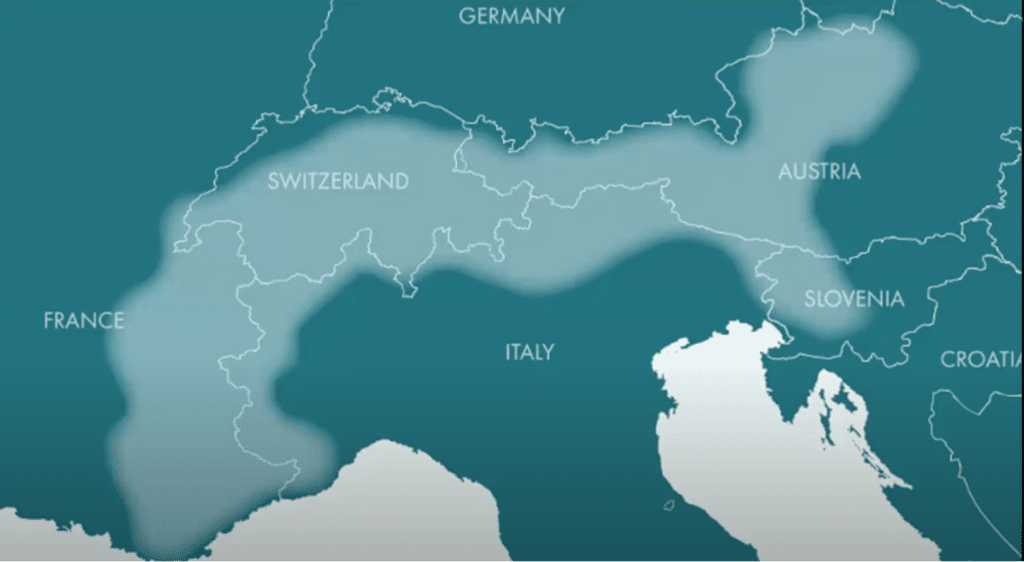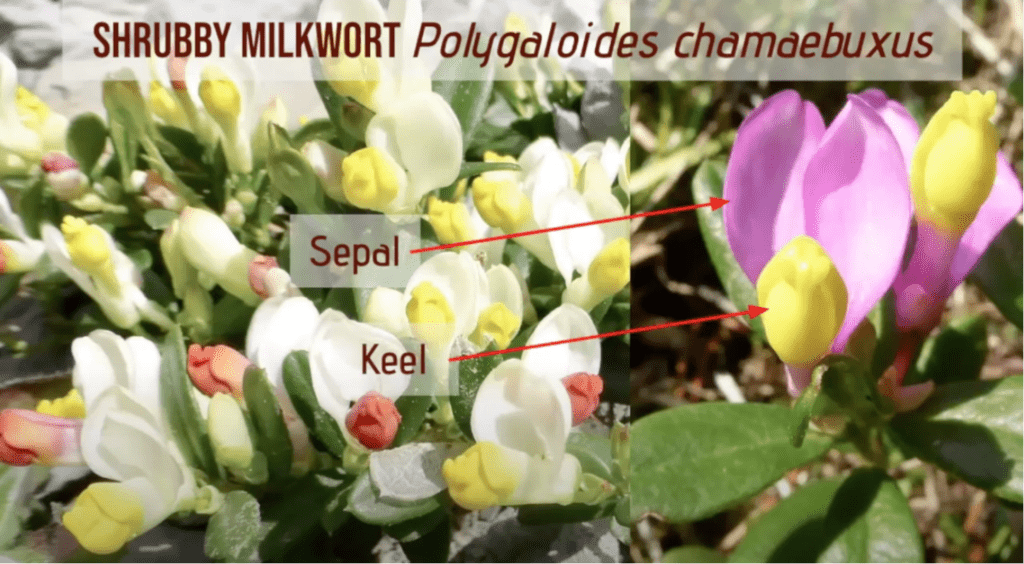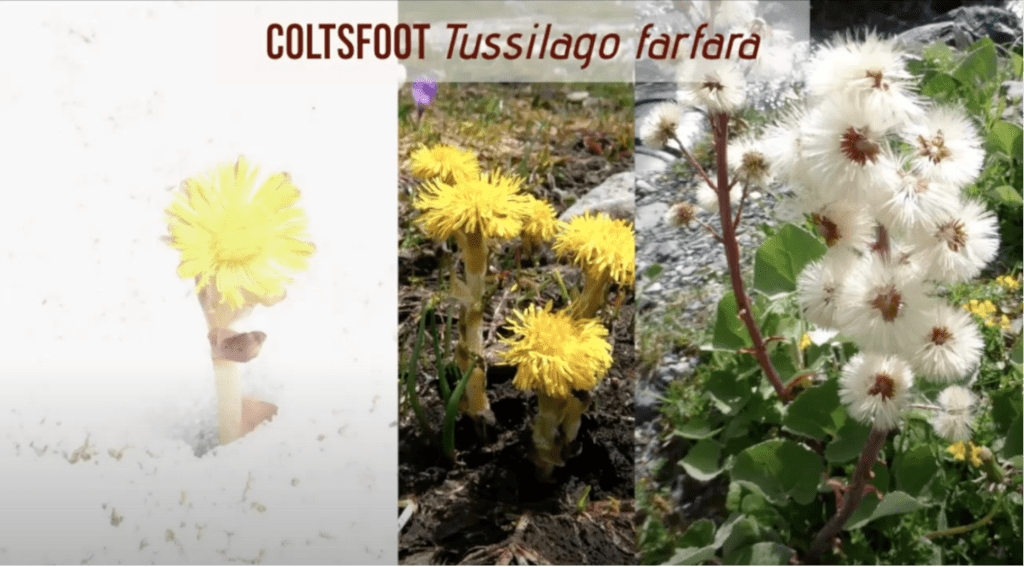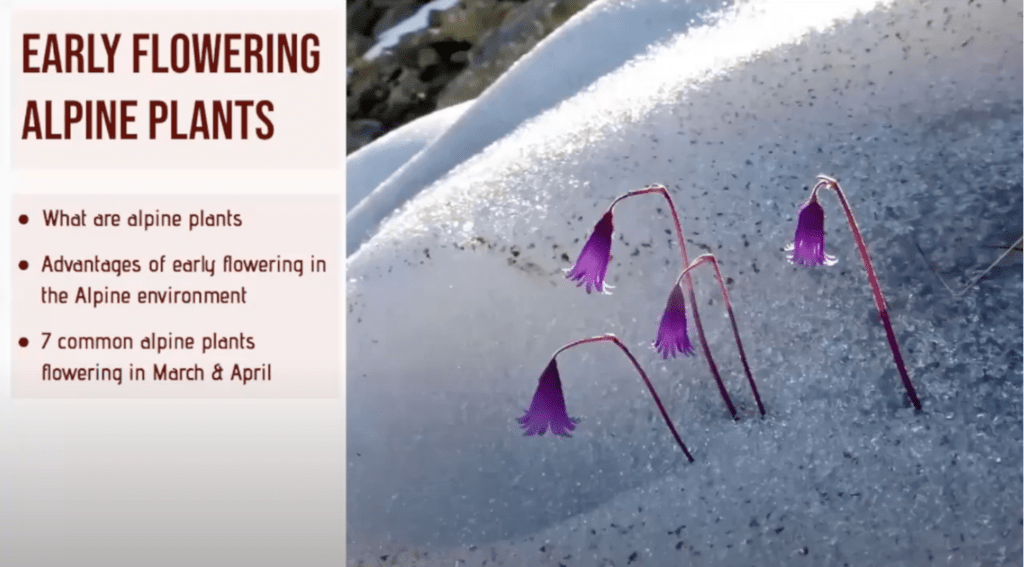We're an affiliate. We hope you love the products we recommend! Just so you know, we may collect a share of sales or other compensation from the links on this page. Thank you if you use our links, we really appreciate it!
Welcome to this bite-sized memorable look at the world around us. This window into nature is taking a closer look at a selection of early flowering plants you’ll see in the alps. We’ll also cover what an alpine plant is and what are the advantages of early flowering in the season.
So, the alps form one of the great mountain ranges in the world and they span 1200 kilometers from France in the west through Switzerland, Lichtenstein, Italy, and Germany and right across to Austria in the east and Slovenia in the southeast. They’re a narrow band between 150 to 200 kilometers wide.

What is an alpine plant?
Simply put they are plants that grow and are found above the natural tree line some of these are found above the natural tree line exclusively but others can be seen flowering at lower altitudes.
In total the European alps are home to over 600 truly alpine species which exist entirely above the forest limit. Alpine flowers often have beautiful colors as you can see in this example here.

They tend to be small, and they tend to have a large well-developed root system to be able to store sugar and provide good anchorage.
What are the advantages of flowering early in the season?

Living in the alpine environment is largely one of climatic severity. And survival plays a significant role for the specialist alpine plants. And it favors those that can minimize the climatic impacts. Either through avoidance or tolerance.
Exposing delicate flowers in early spring is a risk to the plant and the function of the flowers to reproduce through pollination. So, taking advantage of the brief alpine growing season by flowering early is certainly an advantage.
The alpine summer is very brief and the pressure to complete the process of flowering through to producing seeds in a short amount of time is necessary. And not to mention it’s expensive in terms of energy as they also have to grow and repair and fight infection.
Saying that their large bright-colored flowers appear shortly after or even during snowmelt in the spring and take advantage of the strong solar radiation.
1. Shrubby Milkwort Polygaloides chamaebuxus

The first of the seven species we’ll look at is Shrubby Milkwort.
It’s a low matt forming evergreen plant and it’s got woody stems. The leaves you can see there are shiny green and leathery. And the flower is made up of these outer protective sepals we see there which can either be white yellow or even a lilac color and they’re like a pair of bunny ears.
Then the inner part of the flower, the keel or the petals, are often bright yellow and they age to a reddish-brown color. These are found right across the alps, quite scattered but you’ll see them from 600 meters right up to 2400 meters.
2. White Crocus Crocus albiflorus

The white crocus flowers early in march you can see it right through June.
Stemless plants and it’s got an underground corm or a bulb so they come out early from the development from within that bulb. The leaves are narrow and grass-like and as you can see there you’ve got a white mid-rib. And the flowers are white or violet and sometimes they have feathery violet stripes as well.
But not only can the crocus start growing before the snow’s disappeared, but it’s even able to successfully flower and fruit below snow cover. So, it truly is an early pioneer and again you’ll see these on damp nutrient-rich meadows among snow patches up to two 2500 meters right across the Alps.
3. Coltsfoot Tussilago farfara

Another of the march flowering plants and these coltsfoots will flower right through July. And their bright yellow daisies have solitary flowers on these scaly stems which can be crimson or yellow.
And it’s again another plant that can grow beneath the snow. Its metabolism helps to melt the surrounding snow and it appears through so it does take advantage of the early sun. And it’s probably a reason why the leaves aren’t produced until the seeds have developed.
Because there’s no point in having a leaf that is delicate under the snow and the harsh early spring so it’s a good adaptation to early spring.
The Latin name Tussilago relates to tuchis which means to cough. And historically the plant was used as a remedy for coughs and colds.
4. Spring Heath Erica carnea

Spring Heath this is the fourth flower that you’re likely to see from March onwards. It flowers right through June. It’s a dwarf shrub and it’s got needle-like leaves, which are rolled in and curled, and the margins are rolled underneath.
Underneath that the lower side of the leaf is the breathing pores the stomata which are hidden and sunken and surrounded by little hairs. It helps to prevent water loss through transpiration, so good adaptation to living early spring hot sun.
As you can see the flowers are bright pink and they got this protruding purple anther in the center. They appear as nodding drooping bells. It’s a calcium-loving plant found at low levels from 500 meters right up to 2500 meters. It’s a common plant right across the Alps.
5. Purple Saxifrage Saxifraga oppositifolia

Purple saxifrage is one of my favorite alpine flowers. It’s a remarkable plant with wonderful bright pink blooms as you can see here. It’s the highest flowering plant in the alps just over 4400 meters in the Mischabelhörner area in Switzerland.
It’s been recorded as the most northerly flowering plant in the world and has been found right across the northern hemisphere from Canada to Japan.
And it’s a low mat-forming plant with these trailing stems and the leaves are the opposite hence its name Saxifraga oppositifolia
And have sometimes hairy but often they have this lime and crusting which is a mechanism by the leaf pushing out excess calcium salts to help maintain the calcium balance within the leaf.
The name Saxifrage comes from Latin Saxon meaning rock and french air or fragile if you consider that to break so it essentially means rock breaker.
But they’ve found that they do not break the rocks but they’re found amongst broken or frost-shattered rocks and they take the nutrients which are released as the rocks are shattered hence, they have this big root network as well.
So, they’re true pioneers of this eking out the mega kind of nutrients that you find in these environments.
6. Spring Gentian Gentiana verna

Spring Gentian it’s one of the earlier flowering Gentian. Pale or deep blue solitary flowers they’re unbranched. The centers have a white frilly center of the pretty disc the center and the leaves are bright green.
And one of the key features is they don’t have many leaves on the scent but they have a basal ring or a rosette of leaves. Another key feature is the sepals are winged as you can see there.
We saw the earlier picture of the Shrubby Milkwort with the two bunny ears which were sepals. But here the settles are more characteristic of a flower where they’re more protective and not quite as distinctive. But they help with the identification, and they are a true part of a flower’s anatomy.
7. Spring Pasqueflower Pulsatilla Vernalis

And finally, we look at the Spring Pasqueflower, flowers from April right through July. It’s a distinctive plant very hairy as you can see there. The outside of the petals of these and the bracts have these bright or bushy hairs sometimes golden in color.
The stems are leafless but you just have a base rosette of leaves. And the flowers open for a short time during the morning maximizing the sun’s energy, but they don’t open first thing in the morning or the afternoon. It’s just the morning and they’ll follow the sun. Unusually for track flowers, it offers nectar as a reward to its pollinators.
Credit to: Jim from https://www.natureswork.co.uk

We’re passionate about getting the most from your car when it comes to going on adventures and road trips. When you take one of these trips you often need more room in your car than you usually would. This is when we come in, to help you find the best roof tent for your car and needs.

